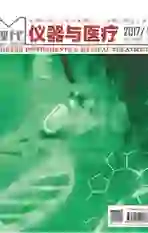肩前外侧经三角肌入路内固定在肩关节脱位合并肱骨大结节骨折中的应用
2018-01-09李仁杰
李仁杰
[摘 要] 目的:觀察肩前外侧经三角肌入路内固定在肩关节脱位合并肱骨大结节骨折中的效果,总结临床应用体会。方法:回顾85例肩关节脱位合并肱骨大结节骨折患者临床资料。接受肩前外侧经三角肌入路微型钢板螺钉内固定者为观察组(n=39),接受传统肩前三角肌、胸大肌入路肱骨近端解剖钢板螺钉内固定者为对照组(n=46),比较两组手术情况、恢复情况及并发症发生情况,并评价其术后9个月肩关节功能优良率。结果:观察组切口长度、手术时间、术中出血量均低于对照组,差异有统计学意义(P<0.05)。与术后1 d相比,两组患者术后3~10 d患肩根部周径逐渐下降,观察组术后1~7 d患肩根部周径均低于对照组,差异有统计学意义(P<0.05)。两组骨折愈合时间差异无统计学意义(P>0.05)。观察组术后肩峰下撞击综合征发生率为5.13%(2/39),低于对照组的10.87%(5/46);观察组术后9个月肩关节功能优良率为87.18%,高于对照组的56.52%,差异均有统计学意义(P<0.05)。结论:与传统入路相比,肩前外侧经三角肌入路能够进一步降低手术创伤、缩短手术时间、降低术后肩峰下撞击综合征发生率、促进早期恢复,是一种安全、可靠的新型入路方案。
[关键词] 肩前外侧;三角肌入路;内固定;肩关节脱位;肱骨大结节骨折
中图分类号:R684.7 文献标识码:A 文章编号:2095-5200(2017)05-106-03
DOI:10.11876/mimt201705044
The use of internal fixation of shoulder anterolateral by the deltoid approach in the shoulder joint dislocation combined with the greater tuberosity of humerus LI Renjie. (Department of Orthopedic Surgery,Meishan Second Peoples Hospital, Meishan 620500, china)
[Abstract] Objective: The objective of this study was to observe the effect of internal fixation of shoulder anterolateral by the deltoid approach in the shoulder joint dislocation combined with the greater tuberosity of humerus. Methods: A total of 85 cases of shoulder joint dislocation combined with the large tuberosity of the humerus were collected. The patients who received the internal fixation of shoulder anterolateral by the deltoid approach in the shoulder joint dislocation combined with the greater tuberosity of humerus were divided into observation group (n=39) , while the patients who were treated with traditional fixation of deltoid and pectoralis major muscle by proximal plate screw were considered as control group (n=46). The operation, recovery and complication condition of two groups were compared and their shoulder joint function 9 months after operation were evaluated. Results: The length of incision, the length of operation and the volume of blood loss during the operation of observation group were lower than that of control group, and the difference was statistically significant ( P<0.05). The shoulder suffering diameter of two groups 3~10 days were smaller than that of 1 day after operation, while the shoulder suffering diameter of observation group 1~7 days after operation were smaller than that of control group, and the differences were statistically significant ( P<0.05). The time taken to dislocation recover was not statistically significant ( P>0.05). The occurrence rate of subacromial impingement syndrome after operation of observation group [5.13%(2/39)] was lower than that of control group[10.87%(5/46)]; the excellence rate of shoulder joint function 9 months after operation of observation group (87.18%) was higher than that of the control group (56.52%), and the differences were statistically significant ( P<0.05). Conclusions: Compared to the traditional treatment, internal fixation of shoulder anterolateral by the deltoid approach can further reduce the operative trauma and time and the incidence of complications, which is a novel and reliable therapy.
[Key words] shoulder anterolateral; deltoid approach; internal fixation; shoulder joint dislocation; greater tuberosity of humerus
肱骨大结节骨折多由高能量损伤所致外伤性肩关节脱位引发,手法复位往往难以取得满意效果,多数患者需接受外科治疗[1]。既往临床常用的肩关节脱位合并肱骨大结节骨折治疗方式路以肩前三角肌、胸大肌入路为主[2],但存在手术创伤大、术后恢复慢、并发症发生率高的弊端,故近年来临床开始采用肩前外侧经三角肌入路[3],但目前關于两种入路的横向比较较为缺乏,故对我院2014年8月至2016年7月救治的85例骨折患者进行分析。
1 资料与方法
患者均有明确外伤史,经影像学检查明确诊断[4],病例资料完整且随访时间≥9个月;按照术式将接受肩前外侧经三角肌入路微型钢板螺钉固定者纳入观察组(n=39),将接受传统肩前三角肌、胸大肌入路肱骨近端解剖钢板固定者纳入对照组(n=46),对照组以肩前内侧喙突为标志,向外上延长至肩锁关节,向下延伸至三角前缘中下1/3处,作一长约15 cm的切口,使肱骨大结节骨折断端显露,行骨折复位[5];观察组以肱骨大结节体表处为中心,作一长约3.5 cm切口,逐层切开皮肤、皮下组织,钝性分离,使肱骨大结节骨折断端显露,行骨折复位,而后于肱骨大结节外侧方安置合适的微型钢板螺钉[6]。两组术后患肢均参照相关文献方法开展肩关节功能康复锻炼[7]。
观察术后1 d、3 d、7 d、10 d患肢肿胀程度(以患肩根部周径与伤后6 h之差计算)以及骨折愈合时间(以连续骨痂形成时间计),以(x±s)表示,t检验。术后9个月参照Neer评分系统[8] 评价肩关节功能:优:≥90分;良:80~89分;中:70~79分;差:<70分;优良率=(优+良)/总例数×100%。优良率等计数资料以(n/%)表示,χ2检验,以P<0.05为差异有统计学意义。
2 结果
两组患者年龄、性别、受伤至手术时间、受伤部位、受伤原因、合并伤等一般临床资料比较,差异无统计学意义(P>0.05),本临床研究具有可比性。
观察组切口长度、手术时间、术中出血量均低于对照组,差异有统计学意义(P<0.05)。
与术后1 d相比,两组患者术后3~10 d患肩根部周径逐渐下降,观察组术后1~7 d患肩根部周径均低于对照组,差异有统计学意义(P<0.05)。见表2。观察组骨折愈合时间为(60.13±6.87)d,与对照组的(59.64±7.30)d
比较,差异无统计学意义(P>0.05)。
观察组术后肩峰下撞击综合征发生率为5.13%(2/39),低于对照组的10.87%(5/46),差异有统计学意义(P<0.05),两组患者均未见切口感染、延迟愈合、内固定物失效等其他并发症发生。
观察组术后9个月34例肩关节功能优良,优良率为87.18%,高于对照组的56.52%(26/46),差异有统计学意义(P<0.05)。
3 讨论
肱骨大结节处由冈上肌、冈下肌及小圆肌附着,受外力直接打击或肩袖诸肌猛然收缩牵拉时,常出现大结节骨折[9]。随着撕脱骨块向后上方肩峰下的逐渐移位,肱骨头关节面上可出现大量骨块,进而引发外展、上举功能受限 [10]。与此同时,若患者骨块未得到全面解剖复位,骨折畸形痊愈后,冈上肌、冈下肌、小圆肌长度往往明显缩短,在导致收缩力下降的同时,还可造成关节、滑囊挛缩粘连[11]。 本研究对照组46例患者即接受传统入路股骨近端解剖钢板内固定治疗,其切口长度、手术时间及术中出血量均高于观察组,术后1~7 d患肢肿胀更为明显,且术后肩峰下撞击综合征发生率高达10.87%。这一入路的弊端在于所需切口较长、内固定物较为粗大,且钢板螺钉孔距边缘较远[12],为确保拉力的充分性及固定的可靠性,钢板位置往往偏高,故无法促进肢体肿胀的早期消退,亦难以降低术后并发症发生风险[13]。本研究对照组患者术后9个月肩关节功能优良率为56.52%,与Ogawa等[14]报道结果接近,说明术后早期明显的肢体肿胀与较高的并发症发生率均对患者康复锻炼造成了严重影响,因此,即便传统入路方案能够获得可靠的固定效果,患者肩关节功能恢复质量仍不够理想。
关于内固定物的选择,多数认为可吸收螺钉能够发挥其创伤小、无需二次取出的优势[15],但也有学者指出,可吸收螺钉在拧入时极易因炸裂而失效,且单枚可吸收螺钉抗拔出力低,早期肩关节功能锻炼时极易发生骨块再移位甚至内固定失效,固定功能有限[16]。本研究中观察组患者均在接受肩前外侧经三角肌入路的基础上,以微型钢板螺钉内固定骨折断端,结果表明,得益于微型钢板螺钉体积小、厚度薄的优点[17],患者术后肩峰下撞击综合征发生率明显降低,说明这一入路的安全性也优于传统入路。察组患者术后9个月肩关节功能优良率也达到87.18%,说明该入路不仅能够减少手术创伤、保证治疗安全性,还可提高固定的可靠性,为术后早期功能锻炼的合理开展奠定良好基础。需要注意的是,术中切口应避免向下过度延长,即应局限在肩峰下5 cm内,以避免腋神经损伤所致患侧三角肌萎缩、肩关节功能障碍[18]。
参 考 文 献
[1] Maier D, Jaeger M, Izadpanah K, et al. Proximal humeral fracture treatment in adults[J]. JBJS, 2014, 96(3): 251-261.
[2] 向成浩, 陈文革, 杨朝晖, 等. 肱骨大结节骨折治疗的研究进展[J]. 骨科, 2016, 7(6): 470-472.
[3] 丁凌志, 滕晓, 张招波,等. 三角肌有限劈开入路锁定钢板治疗肱骨近端骨折[C]// 2013中国工程院科技论坛暨浙江省骨科学学术年会论文摘要集. 2013.
[4] Cuff D. Reverse Shoulder Arthroplasty in the Setting of Proximal Humeral Fracture[M]//Reverse Shoulder Arthroplasty. Springer International Publishing, 2016: 163-170.
[5] Spross C, Kaestle N, Benninger E, et al. Deltoid tuberosity index: a simple radiographic tool to assess local bone quality in proximal humerus fractures[J]. Clin Orthop Relat Res, 2015, 473(9): 3038-3045.
[6] Benninger E, Meier C. Minimally invasive lateral plate placement for metadiaphyseal fractures of the humerus and its implications for the distal deltoid insertion-it is not only about the radial nerve. A cadaveric study[J]. Injury, 2017, 48(3): 615-620.
[7] 范永峰. 肩關节脱位合并肱骨大结节骨折的治疗方案分析与疗效评估报道[C]// 2016全国慢性病诊疗论坛. 2016.
[8] DeBottis D, Anavian J, Green A. Surgical management of isolated greater tuberosity fractures of the proximal humerus[J]. Orthop Clin North Am, 2014, 45(2): 207-218.
[9] Rouleau D M, Mutch J, Laflamme G Y. Surgical treatment of displaced greater tuberosity fractures of the humerus[J]. J Am Acad Orthop Surg, 2016, 24(1): 46-56.
[10] Jobin C M, Galdi B, Anakwenze O A, et al. Reverse shoulder arthroplasty for the management of proximal humerus fractures[J]. J Am Acad Orthop Surg, 2015, 23(3): 190-201.
[11] Duralde X A. CORR Insights?: Is Arthroscopic Technique Superior to Open Reduction Internal Fixation in the Treatment of Isolated Displaced Greater Tuberosity Fractures?[J]. Clin Orthop Relat Res, 2016, 474(5): 1280-1282.
[12] Boileau P, dOllonne T, Clavert P, et al. Intramedullary nail for proximal humerus fractures: an old concept revisited[M]//Simple and complex fractures of the humerus. Springer Milan, 2015: 91-112.
[13] 张东, 薛锋, 肖海军. 低切迹锁定小钢板微创治疗肩关节脱位伴肱骨大结节骨折临床疗效[J]. 国际骨科学杂志, 2017, 38(2): 125-128.
[14] Ogawa K, Matsumura N, Yoshida A. Modified osteotomy for symptomatic malunion of the humeral greater tuberosity[J]. J Orthop Trauma, 2014, 28(12): 290-295.
[15] Koljonen P A, Fang C, Lau T W, et al. Minimally invasive plate osteosynthesis for proximal humeral fractures[J]. J Orthop Surg, 2015, 23(2): 160-163.
[16] Buecking B, Mohr J, Bockmann B, et al. Deltoid-split or deltopectoral approaches for the treatment of displaced proximal humeral fractures?[J]. Clin Orthop Relat Res, 2014, 472(5): 1576-1585.
[17] Ryan P, Dachs R P, du Plessis J P, et al. Reverse total shoulder arthroplasty for complex proximal humeral fractures in the elderly: How to improve outcomes and avoid complications[J]. SA Orthop J, 2015, 14(1): 25-33.
[18] Euler S A, Kralinger F S, Hengg C, et al. Allograft augmentation in proximal humerus fractures[J]. Oper Orthop Traumatol, 2016, 28(3): 153-163.
